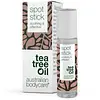What's inside
What's inside
 Key Ingredients
Key Ingredients

 Benefits
Benefits

 Concerns
Concerns

 Ingredients Side-by-side
Ingredients Side-by-side

Water
Skin ConditioningPropanediol
SolventDipropylene Glycol
HumectantCorn Gluten Amino Acids
Skin ConditioningButylene Glycol
HumectantMelaleuca Alternifolia Leaf Oil
AntioxidantGlycerin
HumectantAvena Sativa Kernel Extract
AbrasiveSalix Alba Bark Extract
AstringentCamellia Sinensis Leaf Extract
AntimicrobialChamomilla Recutita Flower Extract
MaskingGlycyrrhiza Glabra Root Extract
BleachingSodium Hyaluronate
HumectantRosmarinus Officinalis Leaf Extract
AntimicrobialScutellaria Baicalensis Root Extract
AstringentPicrorhiza Kurrooa Rhizome/Root Extract
Skin ConditioningPortulaca Oleracea Extract
Skin ConditioningSophora Flavescens Root Extract
AntioxidantAspalathus Linearis Extract
Skin ConditioningLonicera Caprifolium Flower Extract
PerfumingPhellodendron Amurense Bark Extract
Skin ConditioningSalvia Miltiorrhiza Root Extract
Skin ConditioningScutellaria Baicalensis Extract
AntimicrobialPolygonum Cuspidatum Root Extract
AntioxidantCentella Asiatica Extract
CleansingBeta-Glucan
Skin ConditioningXanthan Gum
EmulsifyingHexylene Glycol
EmulsifyingPhenoxyethanol
PreservativeHydroxyacetophenone
AntioxidantEthylhexylglycerin
Skin ConditioningSodium Hydroxide
BufferingLimonene
PerfumingWater, Propanediol, Dipropylene Glycol, Corn Gluten Amino Acids, Butylene Glycol, Melaleuca Alternifolia Leaf Oil, Glycerin, Avena Sativa Kernel Extract, Salix Alba Bark Extract, Camellia Sinensis Leaf Extract, Chamomilla Recutita Flower Extract, Glycyrrhiza Glabra Root Extract, Sodium Hyaluronate, Rosmarinus Officinalis Leaf Extract, Scutellaria Baicalensis Root Extract, Picrorhiza Kurrooa Rhizome/Root Extract, Portulaca Oleracea Extract, Sophora Flavescens Root Extract, Aspalathus Linearis Extract, Lonicera Caprifolium Flower Extract, Phellodendron Amurense Bark Extract, Salvia Miltiorrhiza Root Extract, Scutellaria Baicalensis Extract, Polygonum Cuspidatum Root Extract, Centella Asiatica Extract, Beta-Glucan, Xanthan Gum, Hexylene Glycol, Phenoxyethanol, Hydroxyacetophenone, Ethylhexylglycerin, Sodium Hydroxide, Limonene
Water
Skin ConditioningAlcohol Denat.
AntimicrobialPEG-40 Hydrogenated Castor Oil
Emulsifying4-Terpineol
MaskingPolysorbate 60
EmulsifyingMelaleuca Alternifolia Leaf Oil
AntioxidantCeteareth-25
CleansingGlycerin
HumectantHamamelis Virginiana Leaf Water
AstringentPanthenol
Skin ConditioningTriticum Vulgare Germ Oil
EmollientTocopherol
AntioxidantCamellia Sinensis Leaf Extract
AntimicrobialPotassium Sorbate
PreservativeSodium Benzoate
MaskingPantolactone
HumectantCitric Acid
BufferingLimonene
PerfumingLinalool
PerfumingWater, Alcohol Denat., PEG-40 Hydrogenated Castor Oil, 4-Terpineol, Polysorbate 60, Melaleuca Alternifolia Leaf Oil, Ceteareth-25, Glycerin, Hamamelis Virginiana Leaf Water, Panthenol, Triticum Vulgare Germ Oil, Tocopherol, Camellia Sinensis Leaf Extract, Potassium Sorbate, Sodium Benzoate, Pantolactone, Citric Acid, Limonene, Linalool
Ingredients Explained
These ingredients are found in both products.
Ingredients higher up in an ingredient list are typically present in a larger amount.
Camellia Sinensis Leaf Extract is derived from the leaves of the tea plant. Black tea, green tea, and oolong tea are all harvested from this plant.
This ingredient has many skin benefits:
This ingredient contains polyphenols, a strong antioxidant. Antioxidants help fight off molecules that damage skin cells.
On top of that, the antioxidants in green tea neutralize free-radicals from the sun. This gives the skin some extra UV protection, but should not replace sunscreen.
Many components of tea have anti-inflammatory properties.
Polyphenols and L-theanine help soothe the skin and reduce irritation. The caffeine in Camellia Sinensis Leaf Extract helps calm inflamed blood vessels.
Other compounds found in tea include: Vitamin Bs, linoleic acid, magnesium, calcium, iron, and zinc.
Research has shown both drinking Camellia Sinensis Leaf Tea and applying it to the skin can help boost skin elasticity and hydration. Studies also show using tea extract may reduce sebum, or oil, production.
Learn more about Camellia Sinensis Leaf ExtractGlycerin is already naturally found in your skin. It helps moisturize and protect your skin.
A study from 2016 found glycerin to be more effective as a humectant than AHAs and hyaluronic acid.
As a humectant, it helps the skin stay hydrated by pulling moisture to your skin. The low molecular weight of glycerin allows it to pull moisture into the deeper layers of your skin.
Hydrated skin improves your skin barrier; Your skin barrier helps protect against irritants and bacteria.
Glycerin has also been found to have antimicrobial and antiviral properties. Due to these properties, glycerin is often used in wound and burn treatments.
In cosmetics, glycerin is usually derived from plants such as soybean or palm. However, it can also be sourced from animals, such as tallow or animal fat.
This ingredient is organic, colorless, odorless, and non-toxic.
Glycerin is the name for this ingredient in American English. British English uses Glycerol/Glycerine.
Learn more about GlycerinLimonene is a fragrance that adds scent and taste to a formulation.
It's found in the peel oil of citrus fruits and other plants such as lavender and eucalyptus. The scent of limonene is generally described as "sweet citrus".
Limonene acts as an antioxidant, meaning it helps neutralize free radicals.
When exposed to air, oxidized limonene may sensitize the skin. Because of this, limonene is often avoided by people with sensitive skin.
The term 'fragrance' is not regulated in many countries. In many cases, it is up to the brand to define this term. For instance, many brands choose to label themselves as "fragrance-free" because they are not using synthetic fragrances. However, their products may still contain ingredients such as essential oils that are considered a fragrance.
Learn more about LimoneneThis tea tree oil comes from the leaves of the Tea Tree plant. Tea tree oil has antioxidant, anti-inflammatory, and antimicrobial properties.
According to the book Journal of Profiles of Drug Substances, tea tree helps in reducing acne-causing bacteria such as Propionibacterium acnes. This is due to the Terpinen components of tea tree oil.
Tea tree may cause sensitivity and irritation for some people. This oil naturally contains fragrance such as linalool and limonene.
However, research shows irritation usually occurs when using pure tea tree oil and not in cosmetic products.
Tea tree oil was found to help relieve the symptoms of psoriasis in one study.
Tea tree oil is toxic when ingested. Another study showed it to caused damage to the nervous system of dogs and cats when applied to their skin or given orally.
Learn more about Melaleuca Alternifolia Leaf OilWater. It's the most common cosmetic ingredient of all. You'll usually see it at the top of ingredient lists, meaning that it makes up the largest part of the product.
So why is it so popular? Water most often acts as a solvent - this means that it helps dissolve other ingredients into the formulation.
You'll also recognize water as that liquid we all need to stay alive. If you see this, drink a glass of water. Stay hydrated!
Learn more about Water